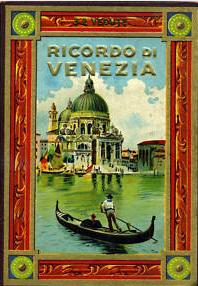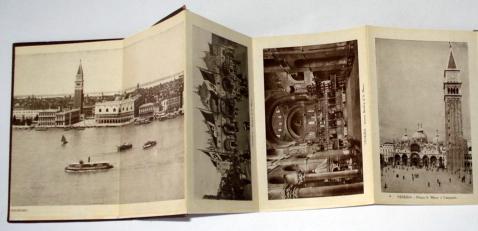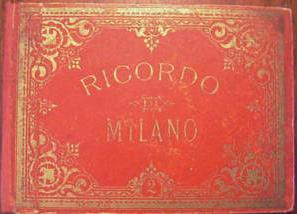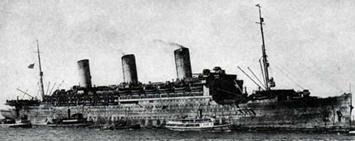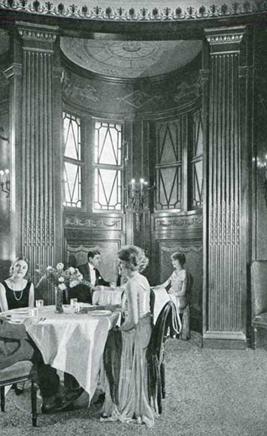These little postcard souvenir booklets were printed all over Italy, by many different printing houses from the 1880s to the 1950s. The two most notable printing houses to produce them were:
Edizione A. (Attilio) Scrocchi
and
Stabilamento Graphico Cesare Capello (Milano)
My booklet has only Cesare Capello's logo embossed on the back cover to identify his Milan-based photography and printing company as it's maker.
You can find many of these booklets for sale on the Internet and in second-hand bookshops. They were printed in the millions for tourists from all over the world making the Grand Tour of Europe.
Italy's Pompeii,
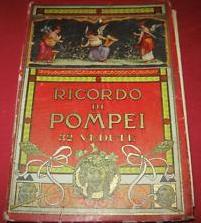
Rome,

Florence
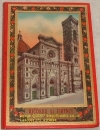
and Venice
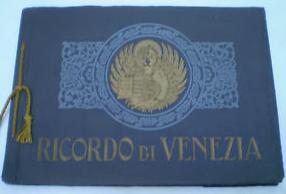
were top of the list for tourist even back in 1880 and earlier, before photography and photo printing became widespread enough to make these booklets viable.
So far I've discovered these postcard-books for these Italian cities:
- Assisi
- Bologna
- Capri
- Como
- Firenze
- Genoa
- Milano
- Napoli
- Padova
- Pisa
- Pompeii
- Torino
- Trieste
And there are books for Italy as a whole, and for special attractions like the Sistine Chapel, that a site visitor just found in the scrapbook format with 37 images.
The size is postcard sized, but the binding can vary. Early books were bound like early scrapbooks, with a tie binding and a hard card cover, sometimes wrapped in printed-embossed linen. Some later books were bound this way too, but more for nostalgia.
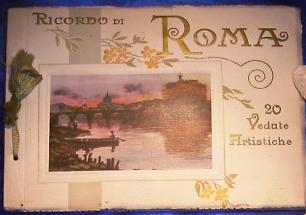
(1910 Scrocchi Edition)
And there were the luxury-editions that were embossed, fully bound, and decorated with gold, or elaborate artwork.
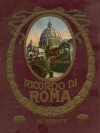
Starting around 1910 the books were covered with cardboard, that was embossed with the title, in gold, and given an elaborate cover image.

By the 1920s, the elaborate cover decor had spread to the back of the book, too.
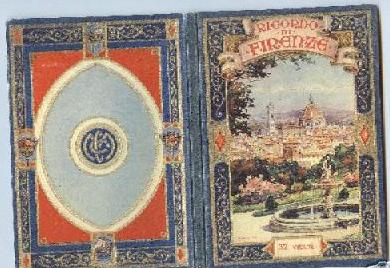
By the 1930s, the postcard photos were usually printed in full color, as you can see in this panoramic view of The Bay of Naples (Vesuvius on the left).

The number of images (vedute-views) can vary, too: 12, 20, 24, 32,
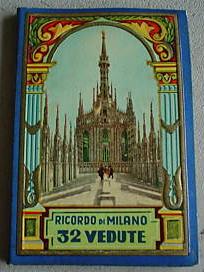
64, 72,
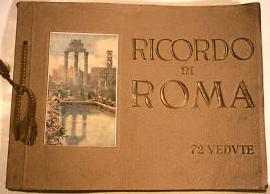
and even a whopping 102 views of Italy.
Over the years they added a map of the town, too, and during Italy's Fascist years, the printers added the explanation text in Spanish, to cater to tourists arriving from Franco's Fascist Spain.
The production of the books seems to have died out by the end of the 1950s.
What are they worth? That depends on how rare they are, and how old, and the condition. But the prices I've seen vary from 2$ to 500$. Not a fortune. If you to own a Ricordo di... book, I'd suggest you do as I've done: keep it and treasure it.
My booklet has inscriptions on the inside of the back cover. The first inscription is by the first owner, her name and address.
Rosa Gomprecht
5 Charlton St.
N.Y.C.
Later Rosa added a gift inscription, when she gave her treasured booklet to someone else.
To Jos. Colp.
And Joseph Colp wrote a later inscription when he gave the booklet to someone else.
For Frederic Jr.
The Internet is a Godsend for curious people like me. I've been able to find this out about the previous owners of my little Ricordo di Venezia souvenir book (forgive me some poetic license).
Rose Gomprecht
Rosa was born November 30, 1861 in New York City, to Jacob Colp and his wife Jette Hernus. The names suggest they come from NYC's large group of German immigrants.
Gomprecht was Rosa's married name. On December 3, 1889, she married Philip Gomprecht in NYC. Philip who was the son of Lompert Lomprecht (or Gomprecht) and his wife Jette Bonorit, both born in Germany, as was Philip.
Rosa and Philip lived together at 151 Bleecker Street, in N.Y.C. In this image from today, 151 has become the 6 story building on the corner. When Rose and Philip lived there, it would have been a brick Federation-Style home like the one to the right of 151.
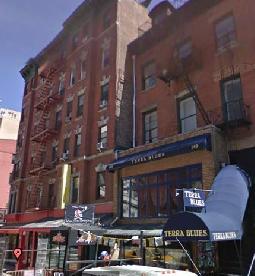
Rose was widowed at the age of 41, in 1902, when Philip died. A site visitor whose wife is related to Rose via marriage, says that Philip was quite a bit older than Rosa, and that she was likely his second wife. The Bleecker Street property was sold to Mr. Israel Lippmann. The records suggest that Rosa and Philip had no children.
Rosa's address in the inscription is 5 Charlton St., N.Y.C. That address is now number 9 Charlton Street, on the corner on 6th Avenue, the Avenue of the Americas.
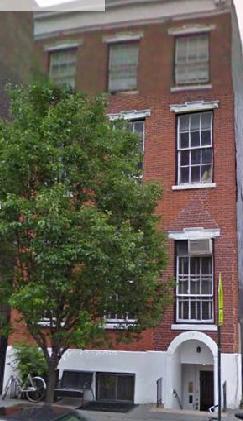
It is one of the few Federation-Style homes still there, with a long, green backyard right up against the avenue. These addresses all fall within an area that spread across to Tompkins Square, that was called "Kleindeutschland" or Little Germany, because of the large number of immigrants from Germany, and their descendents, who lived there.
In 1923, at the age of 61, Rosa travelled to Europe, including Italy in her Grand Tour. It was certainly on this trip that she purchased her Ricordi di Venezia booklet, the one I now own.
Rosa returned to New York City on September 24, 1923, on the largest passenger ship in the world at that time: the S.S. Leviathan. That voyage began in Southampton, England on September 18. The crossing of the Atlantic Ocean took 6 days. (I have more about the S.S. Leviathan in the left column.)
Jos. Colp / Joseph Colp
From what I can find out, Joseph Colp was most likely Rosa's contemporary, living in New York City with his wife, Sophie Colp. Colp was Rosa's maiden name, so he would have been a relation on her father's side, possibly a brother, although I find no record of her having a sibling.
"Jos. Colp" is the name of a well known store in New York City at that time. Many of NYC's stores and department stores were owned and run by Germans and German immigrants. It is possible that the Jos. Colp of the ricordi book is the Jos. Colp of the store.
My trail ends there. At some point Joseph and Sophie passed the booklet on to a Frederic Jr. A grandson, perhaps? Maybe.
How I got the booklet, I have no idea. It is a mystery, or one of the ironies of the modern age, when the time of Rosa Gomprecht is better documented than our own? It would seem so.
C.M.


